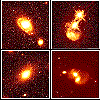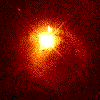The first image shows six quasars. The column of images on the left represents normal galaxies; the center, colliding galaxies; and the right, peculiar galaxies.
Top center: The photo reveals evidence of a catastrophic collision between two galaxies traveling at about 1 million mph. The debris from this collision may be fueling quasar IRAS04505-2958, which is 3 billion light-years from Earth.
Bottom center: Hubble has captured quasar PG 1012+008, located 1.6 billion light-years from Earth, merging with a bright galaxy (the object just below the quasar). The two objects are 31,000 light-years apart.
Top right: a tidal tail of dust and gas beneath quasar 0316-346, located 2.2 billion light-years from Earth.
Bottom right: two merging galaxies that may have orbited each other several times before merging, leaving distinct loops of glowing gas around quasar IRAS13218+0552. The quasar is 2 billion light-years from Earth.
The second image shows quasar PKS2349. Only 11,000 light-years separate the quasar and the companion galaxy (located just above the quasar). The galaxy is closer to the quasar's center than our sun is to the center of our galaxy. Eventually, the galaxy will fall into the quasar's engine, the black hole. Black holes are believed to power the compact, energetic quasars. The black hole will gobble up this companion galaxy in no more than 10 million years.
From the following articles you can get full sized images. Thumbnails on the left give access to smaller versions

